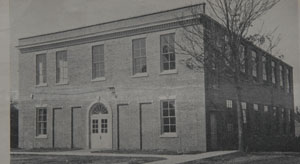

Drewry Practice High School Building |
||||||
|
||||||
Drewry High School served as a training site for teacher education students at Talladega College. While the school displayed aspects of an experimental program, another reason for inclusion in the Secondary School Study evolved from the college’s participation in the ongoing Cooperative Study in General Education (1938–1947), funded by the General Education Board and sponsored by the American Council on Education (Zayed, forthcoming). The Cooperative Study represented another implementative research project, involving twenty-two colleges; Talladega College was the only black school among the original participants. Drewry Practice School (junior high grades 7–9 and senior high grades 10–12) maintained a teaching staff of 12 teachers and a full-time librarian for over 100 students. Drewry administrators were quite proud of the cooperative effort on the part of teachers and pupils to establish a school library and to review and select books. The high school received regional accreditation in 1934 and was an original institutional member of the Association of Colleges and Secondary Schools for Negroes.
Drewry Hall was constructed in 1932 and served as the high school building until its closing in 1948, due officially to fiscal matters; however, Drewry and Doermann stated in Stand and Prosper: Black Colleges and Their Students that Drewry High School’s presence served as a deterrent for the town of Talladega to accept responsibility for providing public high school education. Drewry’s closure led to the opening of a black public secondary school (Drewry and Doermann, 2001, p. 149). The Drewry High School building still stands on the campus of Talladega College. Talladega College, founded in 1867 by the American Missionary Association, embraced a mission of racial equality. The college’s secondary school sought “to develop the habit of using intelligence and tolerance rather than emotion in judging racial, political and religious groups other than his own,” and its publications noted the significance of democracy while also underscoring the importance of academic training (Gay, 1942, p. 5). Since Talledega College was an integrated institution, administrators saw the significance of maintaining an interracial elementary and secondary school. This led to some tensions. As noted in the Study’s final report, Serving Negro Schools, “there still exists a wide rift between the college and the community—and Drewry High School is a part of the college. There is suspicion and distrust on the one hand and indifference on the other” (Brown and Robinson, 1946, pp. 25-26). |
||||||

an institutional member of the International Coalition of Sites of Conscience
curator@museumofeducation.info



